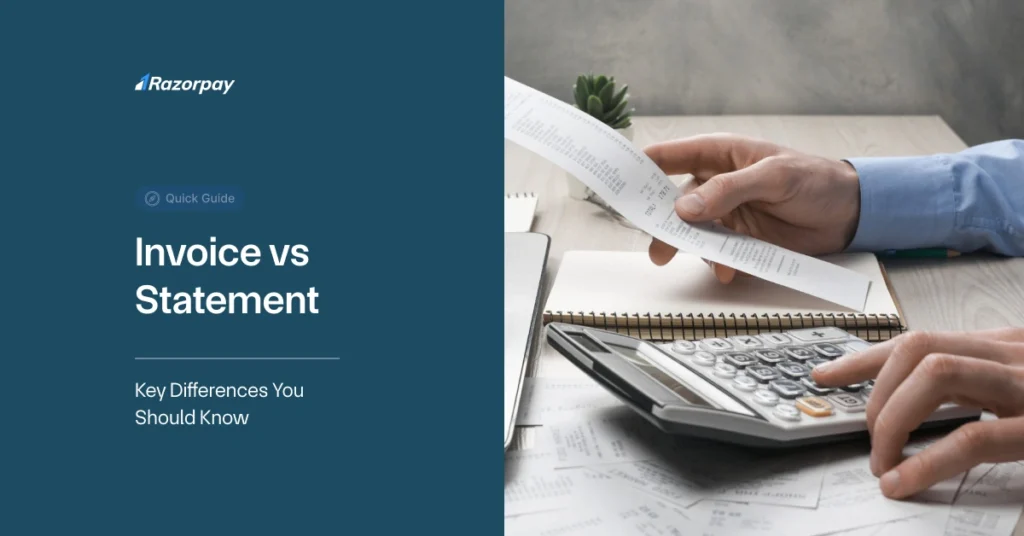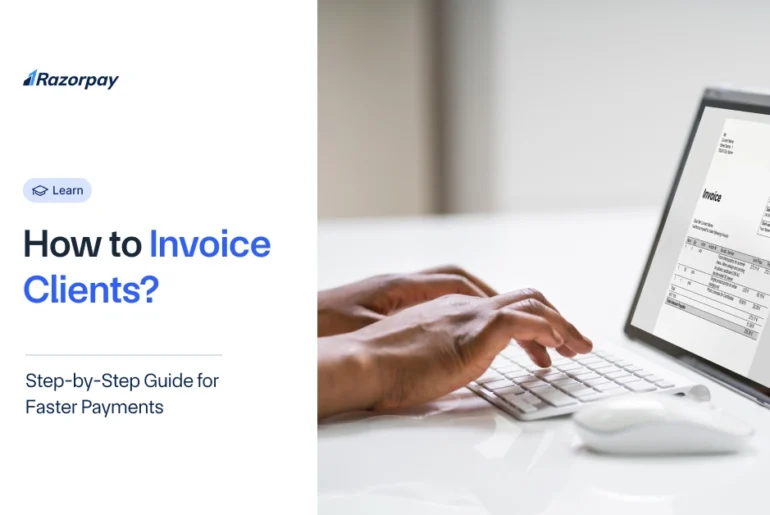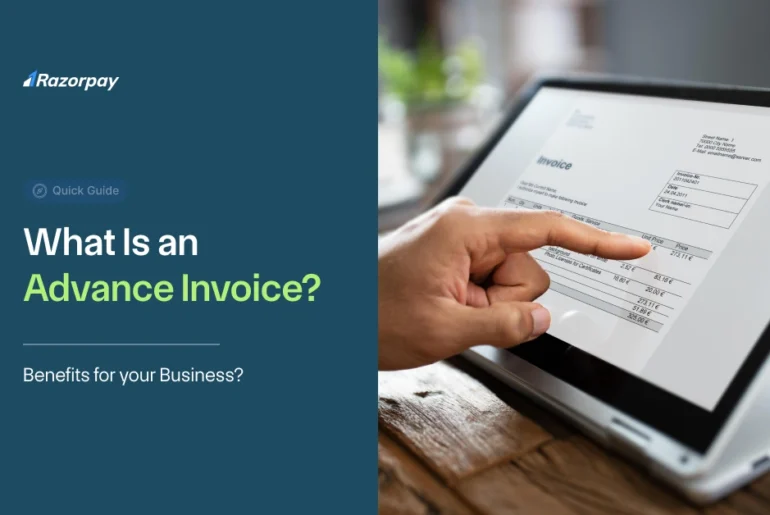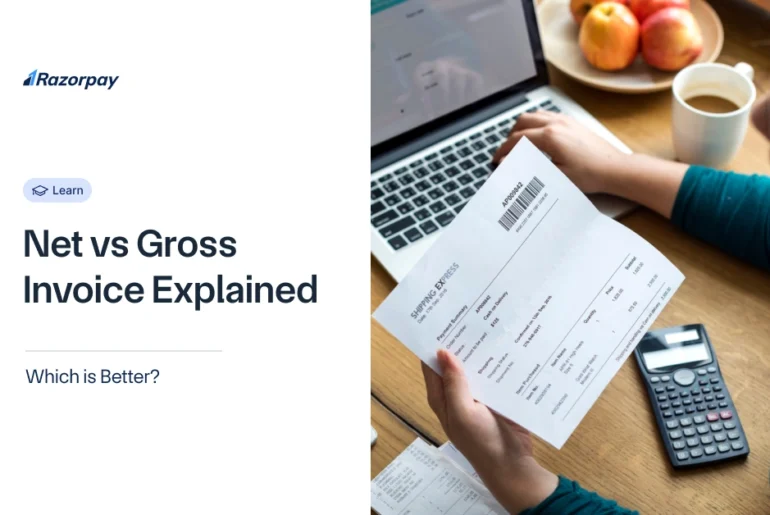Table of Contents
Invoice vs Statement: A Detailed Comparison
At a glance, invoices and statements may seem similar, but they serve entirely different purposes in business finance. An invoice is a formal request for payment, issued every time a product is sold or a service is rendered. A statement, on the other hand, is a summary of transactions over a set period, designed to give customers a consolidated view of their account status.
This confusion between the two can lead to delayed payments, accounting errors, or miscommunication with clients. That’s why understanding the difference between an invoice and a statement is essential for maintaining smooth financial operations.
Here’s a breakdown of how they compare:
|
Aspect |
Invoice |
Statement |
| Purpose | Request payment for a specific product or service | Summarize account activity over a time period |
| Timing | Issued per transaction | Sent periodically (e.g., monthly or quarterly) |
| Information | Itemized list, total due, due date, payment terms | Opening balance, transaction history, total outstanding |
| Use Case | Used to collect payment | Used for account reconciliation and customer reminders |
| Payment Expectation | Immediate or scheduled payment required | May or may not require payment (based on outstanding dues) |
Issuing the right document at the right time can make a big difference. Use invoices to trigger prompt payments and record revenue, and use statements to maintain clarity in client accounts, especially when dealing with recurring transactions.
Many businesses use both: they issue invoices to request payments and send out statements at the end of the month to show clients what’s been paid, what’s pending, and where things stand overall.
What Is an Invoice?
An invoice is a formal document issued by a seller to a buyer, requesting payment for goods delivered or services rendered. It is a crucial part of the billing process in both B2B and B2C transactions, acting as a legally binding request for payment. Invoices are typically issued immediately after the delivery of goods or the completion of services. In some cases, recurring or scheduled invoices are sent based on pre-agreed billing cycles.
The primary purpose of an invoice is to serve as an official payment request, ensuring both parties are aligned on what is owed, for what, and by when. It helps businesses:
Key Components of an Invoice
Every invoice includes standardized elements that make it a clear and traceable financial document. Here’s what a typical invoice contains:
- Invoice Number: A unique identifier to track and reference the invoice
- Itemized List of Goods/Services: Descriptions, quantities, and individual rates for each product or service provided
- Payment Terms: Conditions such as “Net 15” or “Due on receipt,” which define when the payment is expected
- Invoice Date & Due Date: Clearly indicating when the invoice was issued and when payment is due
- Subtotal, Taxes & Total Amount Due: Including applicable taxes like GST, and the final amount to be paid
- Business Details: Name, address, contact info, and tax registration numbers (e.g., GSTIN) of both the seller and buyer
- Payment Instructions: Bank details, UPI ID, or integrated payment links
Businesses use invoices as a foundational tool to manage accounts receivable, ensuring timely collections and clear financial records. They can be issued as one-time invoices for ad-hoc sales or project-based services, or as recurring invoices for ongoing subscriptions, retainers, or monthly billing cycles.
By issuing timely and detailed invoices, businesses can reduce payment delays, strengthen client communication, and maintain a healthy cash flow.
What Is a Statement?
A statement is a summary document that outlines a customer’s account activity over a specific time period, typically monthly. Unlike an invoice, which is a direct payment request, a statement serves as a snapshot of the overall financial relationship between a business and its customer.
The primary purpose of a statement is not to demand immediate payment, but to help both parties reconcile past transactions and identify outstanding balances. It is particularly useful when dealing with clients who have multiple transactions within a billing cycle or ongoing business relationships.
A standard account statement usually includes:
- Opening balance – the amount owed or carried over at the beginning of the period.
- List of transactions – this includes all invoices issued, payments received, credits applied, and refunds processed within the selected date range.
- Total amount due – the net amount the customer currently owes, if any, after accounting for all transactions.
Statements help in maintaining financial clarity, especially when there are multiple ongoing transactions. Businesses often issue statements on a regular schedule (monthly or quarterly) to allow customers to verify records, ensure accuracy, and plan for upcoming payments if needed.
Statements are particularly helpful in industries where clients make frequent purchases, such as wholesale distribution or long-term service contracts. By offering a consolidated view, they help reduce disputes and support efficient account reconciliation.
When to Use an Invoice vs a Statement?
Choosing between an invoice and a statement comes down to the objective of the communication: do you want to collect payment or summarize financial activity?
Understanding the correct document to use helps businesses maintain accurate records, avoid confusion, and improve payment timelines.
Use an Invoice When:
An invoice is your go-to document when you’re requesting payment for specific goods or services. It’s best used when:
- You’re billing a client immediately after delivering a service or shipping a product.
- You need to set clear payment terms, including a due date and late fees.
- You operate on a project-by-project basis, such as freelancers, consultants, or creative agencies.
- You offer one-time transactions or custom pricing.
For example, a freelance designer sends an invoice to a client after delivering a completed website design, requesting payment within 15 days.
Use a Statement When:
A statement is better suited for situations where clients have ongoing transactions or you want to provide a summary of account activity.
Use it when:
- A customer has multiple outstanding invoices across a billing cycle.
- You need to track long-term transactions, such as monthly purchases, partial payments, or returns.
- You’re sending reminders or supporting documents to help clients reconcile their records.
- You’re running a subscription-based or credit-based business model.
- You need to show a running balance and help clients view their current financial standing.
For example, a wholesale supplier sends a monthly statement to a retailer, summarizing purchases, payments, credits, and the total balance due.
Benefits of Understanding the Difference
Distinguishing between an invoice and a statement is more than just a technicality—it’s key to running a financially healthy business, whether you’re managing five clients or five hundred. Understanding which document to send and when can significantly boost your operational efficiency.
Improved Financial Communication
When you clearly know when to send an invoice versus a statement, your clients know exactly what’s expected. This clarity:
- Reduces the likelihood of missed payments
- Eliminates confusion around due amounts
- Builds trust and professionalism in client relationships
Efficient Payment Management
Using the correct documents ensures that you:
- Have a clear record of outstanding payments
- Avoid duplicate communication or errors in billing
- Keep your accounts receivable streamlined and up to date
This becomes even more critical as your business scales and the volume of client transactions increases.
Enhanced Cash Flow
Timely and accurate invoicing encourages prompt payments. Meanwhile, periodic statements help customers stay on top of their dues, particularly when multiple invoices are involved. Together, they:
- Support better cash flow forecasting
- Minimize payment delays and disputes
- Provide the documentation you need for account reconciliation
Common Mistakes to Avoid When Using Invoices or Statements
Even the most organized businesses can slip up when handling invoices and statements. These errors might seem minor, but they can cause delays, confusion, or even lost revenue. Here are the most common pitfalls and how to avoid them:
1. Confusing Invoices with Statements
One of the biggest mistakes is using the terms invoice and statement interchangeably. While an invoice is a formal request for payment, a statement provides a summary of account activity.
- Sending a statement when a payment is due may confuse clients and delay payment.
- Conversely, sending an invoice when only an account summary is needed may overwhelm or mislead clients.
2. Missing Critical Information
An incomplete invoice or statement can result in misunderstandings and delays. Common missing elements include:
- Due dates
- Unique invoice numbers
- Itemized charges
- Client contact details
- Payment methods or terms
This lack of detail can make it difficult for clients to process payments or reconcile accounts.
3. Failure to Follow Up
Sending an invoice or statement is just the first step. Many businesses forget to follow up:
- Unpaid invoices should trigger automated reminders or manual outreach.
- Unresolved discrepancies in statements should be flagged and addressed quickly.
Without timely follow-up, even the most accurate documents can go unnoticed or unpaid.
Best Practices for Using Invoices and Statements Effectively
To manage your billing and client communication efficiently, follow these proven best practices for using invoices and account statements:
1. Be Clear and Transparent
Avoid industry jargon or overly technical language in your documents. Instead:
- Use clear labels for items, due dates, and payment terms.
- Keep formatting simple and professional, especially for recurring clients.
Transparency builds trust and improves payment turnaround times.
2. Automate the Process
Use modern invoicing tools like Razorpay Invoices, FreshBooks, or QuickBooks to:
- Set up recurring invoices or auto-generated statements
- Track payment status and overdue amounts
- Send automated reminders for unpaid invoices
Automation minimizes human error and saves time.
3. Timely Follow-Ups
Don’t just send and forget. Establish a consistent follow-up process:
- Send reminders 3–5 days before due dates
- Follow up immediately after due dates pass
- Use email, SMS, or automated notification systems to nudge clients
Timely reminders often make the difference between on-time payment and delay.
4. Regular Account Reconciliation
Reconcile statements at regular intervals to ensure accuracy:
- Match incoming payments with invoices
- Flag any duplicate charges, missed payments, or discrepancies
- Use statements to summarize and validate client balances each month
Conclusion
Understanding the difference between invoices and statements is essential for clear communication, timely payments, and accurate financial tracking.
- Invoices are meant to request payment for specific services or goods.
- Statements offer a broader view of account activity over time.
Using the right document at the right time ensures better client relationships, streamlined reconciliation, and stronger cash flow.
Whether you’re a small business, a freelancer, or a large company managing multiple accounts, mastering these basics is a powerful step toward smarter financial management.
Frequently Asked Questions
1. Can I use both invoices and statements for the same client?
Yes. Many businesses use invoices to request payment and statements to summarize all transactions, especially for clients with ongoing or multiple engagements.
2. What happens if I send a statement instead of an invoice?
Sending a statement instead of an invoice can cause confusion. Since statements don’t specify an amount due per transaction, your client might not realize they need to make an immediate payment.
3. How often should I send statements to clients?
It depends on your business model. Generally:
- For ongoing accounts: Monthly or bi-monthly
- For high-volume clients: Weekly
- For low-volume clients: Quarterly
Set a schedule that helps both parties stay aligned.
Is it better to automate invoice and statement processes?
Absolutely. Automation:
- Reduces manual errors
- Improves consistency
- Ensures timely follow-ups
- Enhances overall payment efficiency



